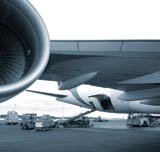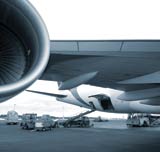
A Balancing Act
Air cargo mandates, maintaining flow of commerce always a concern
- By Mark Laustra
- Jan 01, 2009
 Many of us arrive at the airport extra
early, not simply to catch our
flights, but to factor in getting
through security. Standing in line,
taking off our shoes, watches,
belts and jackets, removing the laptop from its bag, putting
the briefcase and carry-on luggage through an X-ray
machine, walking through a metal detector and, in some
cases, being subject to a pat down or body scan, then
putting everything back together again is a dreary, time-consuming
screening process—all to make sure we can
be trusted to safely board the plane.
Many of us arrive at the airport extra
early, not simply to catch our
flights, but to factor in getting
through security. Standing in line,
taking off our shoes, watches,
belts and jackets, removing the laptop from its bag, putting
the briefcase and carry-on luggage through an X-ray
machine, walking through a metal detector and, in some
cases, being subject to a pat down or body scan, then
putting everything back together again is a dreary, time-consuming
screening process—all to make sure we can
be trusted to safely board the plane.
But what about those items going into the belly of
the same plane you boarded after undergoing such
extensive passenger security measures? The issue of
how to mitigate the risk of an event in air cargo has
largely been off-radar over the past few years, taking a
back seat to passenger and baggage screening. That is
about to change.
A Shift in Priority
The 9/11 Commission Act of 2007 mandates the screening
of 50 percent of all cargo transported on passenger
aircraft by February.
The Transportation Security Administration is now
lawfully charged with finding the technology to screen
all cargo being transported on passenger planes by
August 2010. Funding and implementing the technologies
is another story.
Specific language of the legislation allows for incremental
increases in cargo screening, requiring that 50
percent be screened at a “level of security commensurate
with the level of security for the screening of passenger
checked baggage” with the 100 percent rule taking effect
no later than three years following enactment.
These measures make sense, as air cargo presents
a significant risk, but what about the challenges of
implementation?
In the early weeks and months after the Sept. 11, 2001,
attacks, it was difficult to know what measures needed to
take priority. Though the attacks were in the United States,
the concern was felt worldwide. The United States’
response included the creation of TSA, charged with the
responsibility of addressing a security landscape that had
literally changed overnight. Tasked with ensuring the continued
viability of mass transit solutions including planes,
trains and buses, the newly created organization was managing
both new and existing threats while enhancing security
in and around the nation’s airports, train stations and
bus terminals.
In order to increase security in airports, TSA has
aggressively evaluated and tested every new viable security
solution and technology available. The extensive
testing process has resulted in the deployment of new
technologies in airport lobbies, security checkpoints,
gates and baggage handling areas. Overall, TSA has
raised security and adjusted nearly all processes and
conceptual operations.
In the effort to mitigate threats and improve overall
security, it has been concluded in airport security that no
simple “silver bullet” solution exists. The improvement
process has been gradual as airports have limitations and
individual challenges that must be addressed carefully
and purposefully.
Starting with metal detectors and X-ray machines,
new technologies have been added to create layered
solutions, including explosives trace detectors, advanced
X-ray systems and even body scanning.
Air Cargo Screening
The challenges of addressing and enhancing air cargo
screening are somewhat unique as cargo may arrive days
or minutes before being loaded onto a plane for final
transport. TSA has largely relied on the industry’s use of
the known shipper program and have supplemented
screening measures with canine teams and TSA cargo
inspectors to ensure air cargo safety.
Air cargo continues to be a significant worldwide
business with a daily average of nearly 12 million
pounds of cargo transported on passenger aircraft.
Congressional oversight has focused on this important
security issue, and Congress has worked closely with
TSA to enhance and strengthen air cargo security measures,
but challenges remain.
The air cargo business is dependent on floor space
and speed of transport. Giving up even a portion of
either space or speed significantly impacts the bottom
line. But the fact remains the mandate is in place and, to
some degree, has now been extended.
Recently, TSA and the directorate-general for energy
and transport for the European Union signed an agreement
regarding air cargo security measures, aligning the
international community in the effort to control risk.
Some of the goals for the agreement include implementing
the 50 percent rule internationally by February with
100 percent screened by the end of 2010.
Speed of Commerce
Time and space. As mentioned earlier, these two simple
factors largely determine the viability of the air cargo
business. Screening and security impact both of these
elements, potentially creating problems for the industry.
To mitigate these impacts, we expect to see companies
buying a good deal of screening equipment to deploy it
in as many locations as possible. This will help eliminate
any choke points and keep the cargo moving
through the process of being unloaded, checked, staged,
loaded and shipped. We also could see cargo being
screened further up the supply chain, earlier in the
process, for the same reason.
Like the initial issues with airport passenger checkpoints,
it will be a process that improves over time with
advances in technology, conceptual operations and staff
training adjustments necessary to implement changes.
Fortunately, a great deal of technology development has
occurred in response to the checkpoint security concerns.
The technology is multi-capable and can be used
for air cargo as well.
Officials from Smiths Detection have been working
with air carriers, freight forwarders and package delivery
companies to help implement and deploy solutions that
will comply with TSA’s mandates. For example, seven of
the top eight major U.S. air carriers have acquired and
deployed almost 400 desktop explosive trace detection
systems for air cargo screening operations. Smiths
Detection has three ETD systems on the air cargo product
list that enable carriers to scan all air cargo for 40 different
explosives.
X-ray systems are another solution that has proven
effective in scanning air cargo. The configurations of the
machines themselves depend on the conceptual operations
of the facility and space. In some cases, entire pallets
are scanned through large X-ray systems. Where
space is an issue, smaller X-ray systems have been used
to enable break-bulk package scanning.
Unique Challenges
The challenge of air cargo screening is two-fold: maintaining
an appropriate level of security while ensuring the
profitability of the business. TSA and air carriers will
rely heavily on technologies that will move cargo through
quickly and still accurately scan for potential security
threats. Technology advancement is the key to mitigate
the time-consuming effects of air cargo screening.
Some upcoming technologies will likely include
advanced integration solutions with remote capabilities
that will tie in existing proven technologies and accommodate
technology advancements.
“Sensors or technologies will be linked together
seamlessly through VoIP connection platforms, such as
its FirstView, thus maximizing layered security solutions,”
company officials said.
VoIP platform solutions also will provide costeffective
ways to extend the reach of the sensors and
data coming from the complex airport environment to
the TSA officers and other appropriate airport officials.
Sensors from both inside and outside the airport
will be monitored remotely, providing officials with
real-time data and monitoring of the entire airport
environment through secure internet access including
command and control, laptop computers and IP handheld
devices.
The air cargo industry also anticipates seeing the integration
of manifest management software, which would
provide a more comprehensive electronic package of
information specific to each piece of cargo. This would be
used for record keeping and forensics if necessary.
As the air cargo mandate deadlines quickly arrive, we
are confident the industry will continue to work closely
and constructively with TSA to develop and implement
solutions that will meet these new
security standards without slowing
down commerce.
This article originally appeared in the issue of .